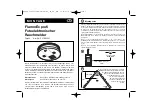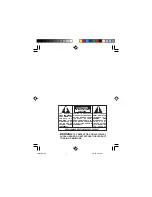
9 P/N 466-5307
• REV A • ISS 15MAR17 ©2017 United Technologies Corporation
Carbon monoxide alarm pattern is four quick beeps repeating every 5 seconds
WARNING: CARBON MONOXIDE ALARM ACTIVATION INDICATES THE
PRESENCE OF CARBON MONOXIDE (CO) AT HIGH CONCENTRATIONS WHICH
CAN KILL YOU.
If the CO condition that caused the alarm in the first place continues, the initiating alarm
unit will reactivate in alarm mode. If the unit goes into alarm mode again within six
minutes, it is sensing high levels of CO which can quickly become a dangerous
situation.
If the CO alarm reactivates within a 24 hour period, call a qualified appliance technician
to investigate sources of CO from fuel burning equipment and appliances, and to
inspect for proper operation of equipment.
If problems are identified during this inspection, have the equipment serviced
immediately. Note any combustion equipment not inspected by the technician and
consult th
e manufacturer’s instructions, or contact the manufacturer directly for more
information about CO safety and the equipment. Make sure that motor vehicles are not,
or have not been, operating in a garage attached or adjacent to the residence.
The detector is operating once it is activated and testing is complete. When products of
combustion (smoke or CO) are sensed, the unit sounds a loud 85dB alarm. See
Detector Visual and Audible Indicators table. In high levels of CO, the unit will go into
alarm in a shorter period of time than at low levels of CO.
The CO sensor meets the alarm response time as follows:
At 70 PPM, the unit must alarm within 60-240 minutes.
At 150 PPM, the unit must alarm within 10-50 minutes.
At 400 PPM, the unit must alarm within 4-15 minutes.
TESTING (PUSH TO TEST BUTTON)
Test your detector every three months by pressing and releasing the test button
quickly. A quick beep will confirm the button has been pushed.
See Detector Visual and Audible Indicators table. The alarm will sound if the electronic
circuitry, horn, speaker, and battery are working. If the alarm does not sound, the
detector must be replaced.
WARNING: DUE TO THE LOUDNESS (85+ DECIBELS) OF THE ALARM,
ALWAYS
STAND AN ARM’S LENGTH (ABOUT 2.5 FT. (0.7M) AWAY FROM THE
UNIT OR USE EAR PROTECTION WHEN TESTING.
Weekly testing is required to ensure proper operation. Erratic or low volume sound (or
no sound) coming from your detector may indicate a defective alarm and it should be










































